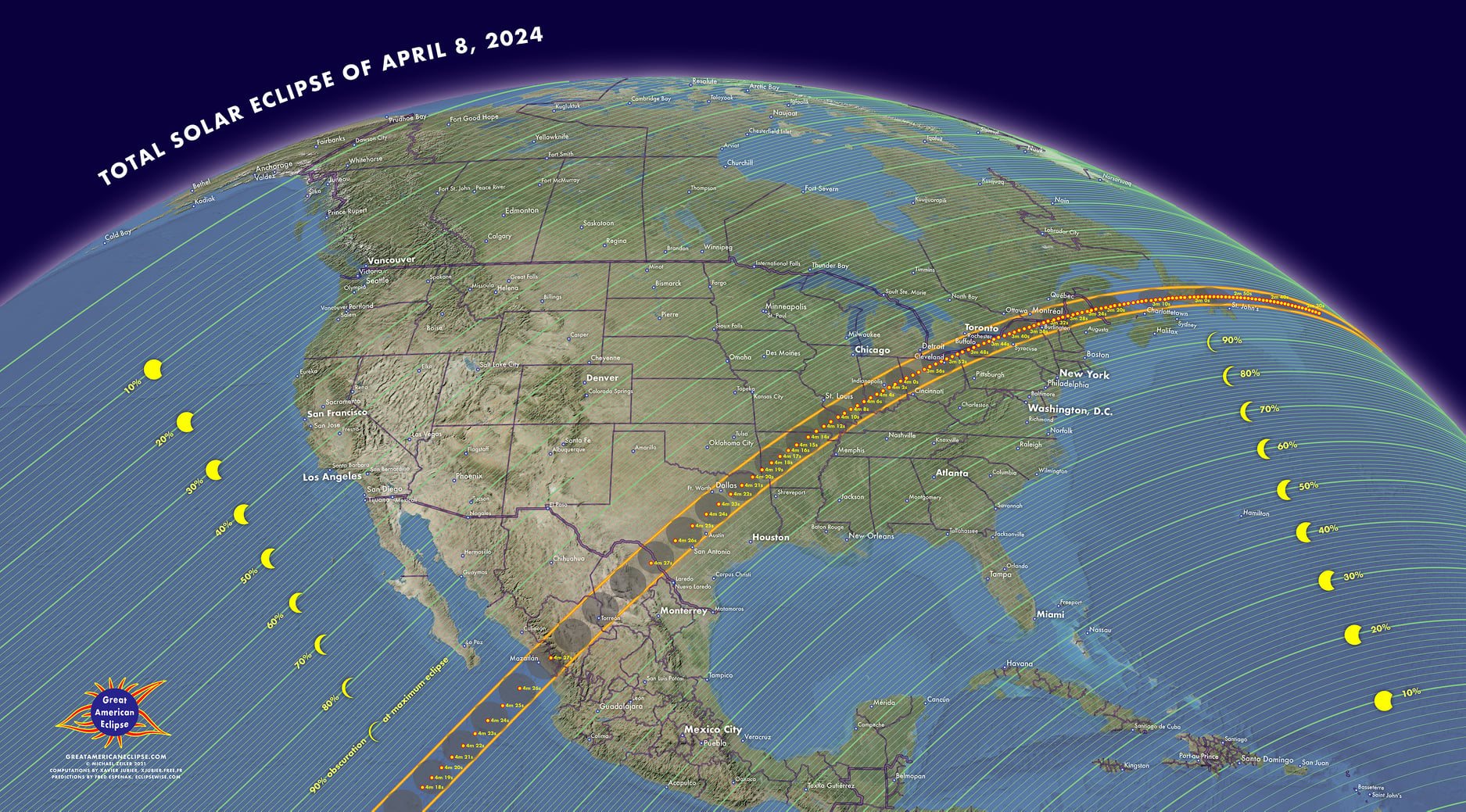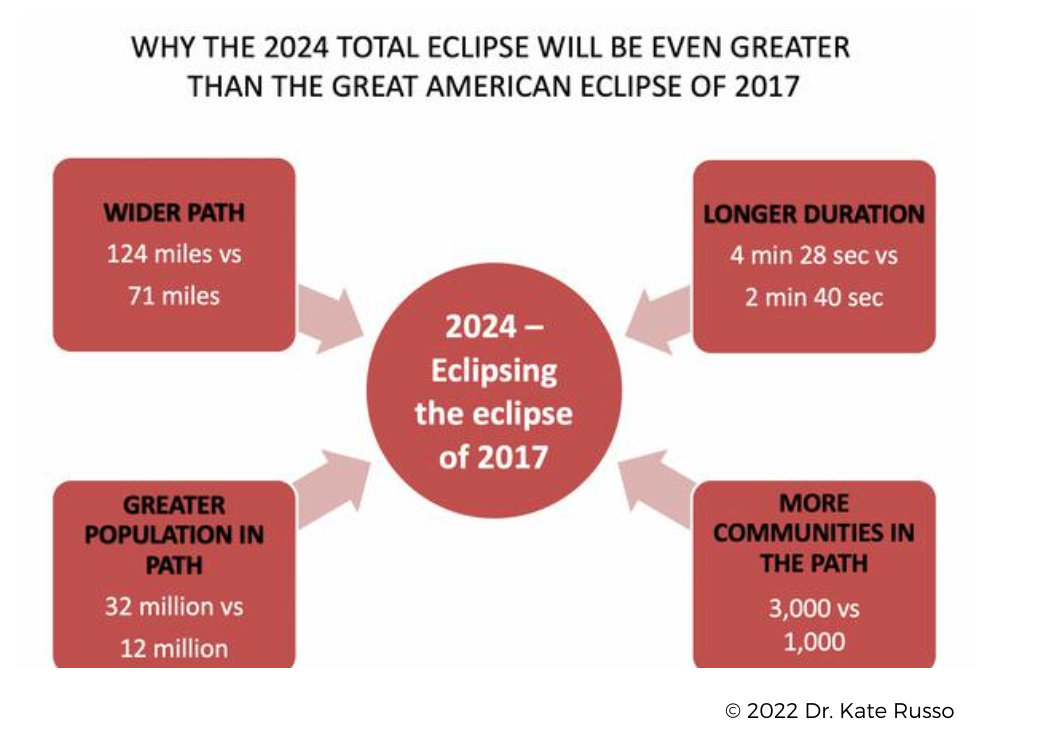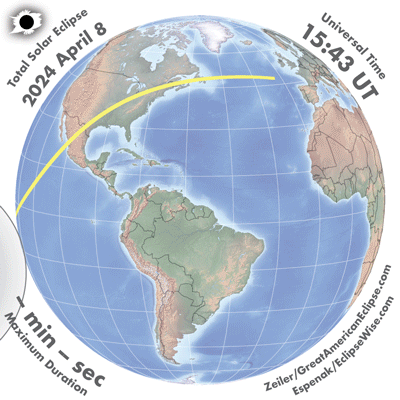TOTAL ECLIPSE 2024: MONDAY APRIL 8
North America hosted the most viewed and accessible total solar eclipse in history – easily eclipsing the ‘Great American Eclipse’ of 2017.
Path overview
The Moon’s shadow for the 2024 total solar eclipse made landfall in Mexico, crossing the regions of Nayarit, Sinaloa, Durango, and Coahuila. The path of totality then crossed the USA from Texas to Maine, including the states of Oklahoma, Arkansas, Missouri, Tennessee, Kentucky, Illinois, Indiana, Ohio, Michigan, Pennsylvania, New York, Vermont, and New Hampshire, while grazing over parts of Canada, including Ontario, Quebec, and New Brunswick.
The path then continued into the Atlantic region of Canada, including Prince Edward Island, Nova Scotia, Newfoundland, and Labrador before heading into the Atlantic.
The whole North American continent, Greenland, and some of Iceland experienced a partial solar eclipse. However, only those lucky few (i.e. 32 million) living within the path of totality and those traveling into the path experienced the full wonder and awe of the total solar eclipse.
On the day, huge segments of the path were under cloud. Areas expected to have the best chances of clear skies found themselves at the mercy of the weather, leading to a mass exodus and significantly fewer visitor numbers in premium locations. Best views on the day were enjoyed by regions that had low visitor expectations – Vermont, New Hampshire, and Canada.
The next total solar eclipse visible from the contiguous United States will not be until August 23, 2044.

Unique path features
- The path of totality crosses regions with high population density, especially over Mexico and the USA
- The path of totality averages around 115 miles wide
- The point of maximum eclipse is in Durango, Mexico, where totality lasts 4 minutes 28 seconds
- The best weather prospects along the path are in Mexico, with the least favorable in Canada
- Within the US, the best weather prospects are to be found in Texas, Arkansas, and Missouri
- This path of totality overlaps with the 2017 path of totality over a region of nearly 9,000 square miles including parts of Illinois, Missouri, and Kentucky
- This path of totality also intersects with the 2023 path of annularity 6 months earlier, exclusively in Texas
- All of North America and Central America will have a partial solar eclipse
- An estimated 32 million people live within the path of totality.
Special planning considerations
- Within the US portion of the track, a number of high-population metropolitan areas both within and near the path will create state-wide challenges for traffic management
- Areas along the western parts of the path, including Mexico and the US states of Texas, Arkansas, and Missouri, are likely to draw the largest crowds due to better weather prospects.
- Other regions along the northeastern part of the path will still draw large numbers based on proximity—even given less favorable weather predictions—simply due to population density
- With the eclipse occurring on a Monday, many people will not be able to travel far due to work and school commitments. Travel into the path is likely to be staggered due to the preceding weekend; however, travel out of the path following the eclipse is likely to cause significant bottlenecks. Planning should include limiting routine traffic on eclipse day
- This eclipse is likely to break all preceding live and online audience viewing records.
The “Great North American Eclipse”
Although hard to imagine, the 2024 total solar eclipse will be even bigger than the “Great American Eclipse” of 2017. With greater awareness, and over double the population living within the wider path of totality, audience numbers are guaranteed to far exceed that of 2017. As the path crosses Mexico, the USA, and Canada, this is likely to be referred to as the “Great North American Eclipse.”
Over 3,000 communities are within the path of totality for this eclipse, with 32 million people living within the path of totality.
National planning for the eclipse is being supported by the American Astronomical Society (AAS) Solar Eclipse Task Force. I have been an active member of this task force for several years.
The (AAS) Solar Eclipse Task Force was initially set up in 2014 to help coordinate national preparations for the “Great American Eclipse” of August 21, 2017. The task force, meant to function as a think tank, coordinating body, and communication gateway/hub, was composed of professional and amateur astronomers, formal and informal educators, eclipse chasers, science writers, and outreach specialists.
With funding from the National Science Foundation (NSF), NASA, and the AAS, the SETF carried out three main activities: (1) built a website with basic information about solar eclipses, safe viewing practices, and eclipse imaging and video, along with resources for educators and the media; (2) managed a mini-grants program to support eclipse-related education and public outreach to underrepresented groups; and (3) organized a series of multidisciplinary workshops to prepare communities for the eclipse and to facilitate collaboration between astronomers, meteorologists, school administrators, and transportation and emergency-management professionals. The safety advice we developed in collaboration with eye doctors was widely endorsed, and our efforts to keep the public safe during the eclipse were successful.
Following the 2017 total solar eclipse, the Solar Eclipse Task Force shifted focus toward preparations for the two solar eclipses that will be visible across North America in the near future – the annular eclipse in 2023; and the total solar eclipse in 2024. The task force has been meeting at least monthly for the past several years via Zoom. Planning workshops have been held virtually throughout the pandemic, with a more recent return to in-person eclipse planning workshops from the end of 2022.
AAS Solar Eclipse Task Force Members:
- Bob Baer (Southern Illinois University, Carbondale)
- Michael Bakich (Astronomy, retired)
- Kelly Clark (AAS Chief Financial & Operating Officer)
- Kristen Erickson (NASA Headquarters)
- Rick Fienberg (AAS Senior Advisor to the Executive Officer), Project Manager
- Andrew Fraknoi (Univ. of San Francisco & San Francisco State Univ.)
- Pamela Gay (Planetary Science Institute)
- Diana Hannikainen (Sky & Telescope)
- Michael Kirk (NASA Goddard Space Flight Center)
- Kelly Korreck (NASA Headquarters)
- Mario Motta (American Medical Association)
- Michelle Nichols (Adler Planetarium)
- Tyler Nordgren (Space Art Travel Bureau)
- Laura Peticolas (Sonoma State University)
- Laurel Radow (U.S. Dept. of Transportation, retired)
- Claire Raftery (National Solar Observatory), Co-Chair
- Shannon Reed (NASA Goddard Space Flight Center)
- Kate Russo (BeingInTheShadow.com)
- Dennis Schatz (Institute for Learning Innovation & National Science Teaching Association)
- Angela Speck (University of Texas, San Antonio), Co-Chair
- Trae Winter (Advanced Research In STEAM Accessibility [ARISA] Lab)
- Michael Zeiler (GreatAmericanEclipse.com)
Several working groups have been formed to guide various aspects of eclipse planning, including working groups for Eye Safety, Web & Social Media, Local Planning, National Planning, Formal Education, Informal Education and Public Engagement, and Media Engagement.


The above video by Rochester Museum & Science Center highlights the total eclipse of April 8, 2024 which passes over the city. The Rochester Solar Eclipse Task Force is well ahead in preparations for the eclipse, and recently played host to one of the AAS Solar Eclipse Task Force Eclipse Planning Workshops attended by communities across the path of totality.
HELPFUL LINKS
The following are links to external sites and are my recommendations for further information about the 2024 total solar eclipse. The focus is on eclipse preparations and planning.
Start here at the AAS official eclipse site for authoritative information. Detailed site with extensive links and resources.
Eclipsophile.com provides detailed analysis of the weather along the path of totality for every total solar eclipse – an essential resource. Run by eclipse chaser Jay Anderson, a Canadian meteorologist.
Eclipsewise.com is the authoritative source for lunar and solar eclipse predictions and information. Run by eclipse chaser Fred Espenak, a retired NASA astrophysicist also known as ‘Mr Eclipse’.
SolarEclipsesGoogleMaps is a feature-laden interactive GoogleMap that allows for detailed exploration of the path of totality future or past solar eclipses. Prepare to spend hours using this tool. Run by eclipse chaser Xavier Jubier, a French IT specialist.
Check out this very cool eclipse simulator tool. Pick your location (within OR outside the path) and play with the simulator to get a good feel for what to expect. Run by eclipse chaser Dan McGlaun.
The fully endorsed, official eye safety guidance used internationally to instruct HOW to view a solar eclipse safely can be found on this authoritative site. Anything that contradicts this information is outdated and wrong.
An extensive site with facts, figures, gorgeous maps, resources and an eclipse-related shop. Start exploring here and get lost for hours.
I am an active member of the AAS Solar Eclipse Task Force, and circulate planning guidance, run workshops, deliver tailored Zoom consultations, detailed strategy plans, community visits, tailored content. Get in touch if you need to know more.
Over 3,000 communities lie within the path of totality. Start here to explore and see what is happening.
